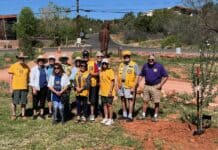Email press releases to editor@larsonnewspapers.com, subject line “Press Release.”
The basics of writing a press release:
- The lead should be catchy, but include the who, what, when, where,why and how much (cost to attend, if applicable) summary of the release.
- A single sentence is best for the first paragraph as a majority of readers often do not read beyond the first 30 percent of a release. Readers should be able to read that first sentence and know all the basic details about your event. If readers have to hunt for information, they’ll often simply not finish reading.
- Write in the third person (using “he,” “his,” “she,” “hers,” “it,” “its,” “they” and “their”), never second person, (“you” and “your”).
- Do not write in all capital letters. Capitalize only proper nouns, (Sedona, Arizona, Oak Creek Canyon, Mayor John Doe) not common nouns (red rock country, the club, the mayor)
- Write in short sentences whenever possible.
- Be aware of our publication deadlines. In the subject line of the e-mail, include the date you wrote the release. Send timely releases early.
- Keep releases short and concise. The goal is to draw the readers’ attention, but not bore them, and direct them to your news item, event or business.
- The proliferation of Internet usage has directly affected print journalism. Newspaper and magazine readers are less likely to read long press releases now more than ever before.
Readers have a tendency to scan print publications they way they do Web site pages as the difference between the two continues to narrow. - Most readers easily comprehend content at an eighth-grade reading level. While Web sites can be highly technical, press releases should be simple. Thus, spell out acronyms, use common phrases, avoid jargon, etc.
- Write for readers who have no concept of your business, product or service before seeing your release. Clearly explain or simply omit specialized terminology. Avoid jargon and unfamiliar terms not used by the general public, or explain what they are.
- Avoid run-on sentences and complicated, compound sentences. Readers are fickle and the first sentence they can’t understand is usually the last sentence of the release that they read. If readers get beyond the first 30 percent then a mixture of compound sentences and short sentences keeps them interested.
If your release includes lists:
- Make them terse.
- Include relevant information.
- Use bullets as they draw the reader’s eye.
- Include at least three items per list.
Photos:
- Always include at least one photo, even if just a headshot or logo. Editors tend to remember releases with associated photos (“Have you seen the release with that photo of the necklace?” is more often heard in newsrooms than “have you seen the release about the new business?”) Even if the photo does not run, the release is memorable to the editorial staff and more likely to run. Readers read press releases with related photos more often then ones without.
- Send large photos, as large as possible. Rule of thumb: If the photo you see on your computer screen is smaller than your hand, it’s too small to publish.
- Photos should be .jpg format and 1,200 to 1,200 square pixels in size or larger at around 300 dpi. Anything smaller runs too small on most presses.
- For example, if your camera shoots 2 megapixels, photos are approximately 2 megabytes in size. This size is more than sufficient. Do not shrink them. Photos that run medium size on a computer screen are too small for us to use. Do not crop photos if at all possible.
- Choose photos with action in them. A posed shot of a person is not as interesting a person “doing” an activity.
- Do not send photos with text written over the image. We can not use these images.
- Do not send flyers instead of photos. We do not run flyers.
- Do not PhotoShop images; i.e.: Do not remove, add or replace backgrounds, add graphic elements, skew, add text, cut or add people from group shots. Adjusting color or levels is fine.
- Always write a caption/cutline for every photo and include full names of the people in the photo. If we don’t have names, we don’t run the photo.
If you include quotes:
- Identify the speaker(s) with full names.
- We use Associated Press style. Thus, use last names on second reference. Thus, if you mention “Bob Smith” at the beginning, use just “Smith” afterward.
- Quotes should include some information not found elsewhere in the release, such as testimonials, personality, or new information.
- Use quotes that are concise and understandable.
- Some quotes may be omitted or truncated for space, so write releases accordingly.
Avoid superlatives (best, favorite, perfect), superfluous adjectives (exciting, world-renowned, internationally known, famous, powerful), and “dead weight” (very, amazing, best, innovative, unique, special) as they tell readers nothing new. They’re the first words copy editors will cut for space, as they dull the impact of the release.
Find out which staff member will receive, edit and place your release. Develop a relationship with courteous, short follow-up e-mails or phone calls. Editors rarely receive thanks.
With any media publication or outlet, do not be a nuisance nor insist on a particular placement. Your press releases are important, but newspapers receive dozens or hundreds of press releases for each issue. Larson Newspapers’ goal is to get as many timely, local, relevant press release into each issue for all of our readers.
All press releases are edited for space and content, no exceptions. Editorial decisions are not personal, they are made for time and spacing concerns and to adhere to Associated Press style. Remember that even “bad” placement or a shortened release still gets seen by tens of thousands of our readers.
Always run spell check before you hit “send.”
Email releases to editor@larsonnewspapers.com, subject line “Press Release.”
Calendar listings:
Calendar listings are straighforward. Who, what, when, time, cost, where, street address, contact phone.
Monday, Jan. 31
Community Gathering: Hosted by John Doe, 5 p.m., free, Sedona Gathering Place, 100 Sedona Drive, West Sedona, 000-0000.
Send press releases via e-mail to Managing Editor Christopher Fox Graham at editor@larsonnewspapers.com or call 928-282-7795 ext. 129.
Send calendar listings via e-mail to Managing Editor Christopher Fox Graham at editor@larsonnewspapers.com or call 928-282-7795 ext 129.


















